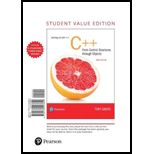
Explanation of Solution
cos():
The C++ library function, “cos()” returns the cosine of an argument.
- To use the “cos()” function, the “cmath” header file is required
- The “cos()” function is useful in some of the scientific and other special-purpose programs.
- The argument and the return type of the “cos()” is double.
Example:
b = cos(a);
Explanation:
“b” is a variable which contains the result of a cosine of the argument where “a” is a argument.
log():
Log is an “inverse operation” to exponentiation.
- To use the “log()” function, the “cmath” header file is required.
- Log returns the “natural logarithm” of argument.
- The argument and the return type of the “log()” is double.
Example:
b = log(a);
Explanation:
“b” is a variable which contains the result of a natural logarithm of the argument where “a” is a argument.
sin():
The C++ library function, “sin()” returns the sine of an angle.
- To use the “sin()” function, the “cmath” header file is required.
- The “sin()” function is useful in some of the scientific and other special-purpose programs.
- The argument and the return type of the “sin()” is double.
Example:
b = sin(a);
Explanation:
“b” is a variable which contains the result of a sine of the argument where “a” is a argument.
exp():
The C++ library function, “exp()” returns exponential function of an argument.
- To use the “exp()” function, the “cmath” header file is required.
- The “exp()” function is useful in some of the scientific and other special-purpose programs.
- The argument and the return type of the “exp()” is double.
Example:
b = exp(a);
Explanation:
“b” is a variable which contains the result of an exponent of the argument where “a” is an argument.
log10():
Log is an “inverse operation” to exponentiation.
- To use the “log10()” function, the “cmath” header file is required.
- Log10 returns the “base -10 logarithm” of argument.
- The argument and the return type of the “log10()” is double.
Example:
b = log10(a);
Explanation:
“b” is a variable which contains the result of a base-10 logarithm of the argument where “a” is a argument...
Want to see the full answer?
Check out a sample textbook solution
Chapter 3 Solutions
Starting Out with C++ from Control Structures to Objects, Student Value Edition (9th Edition)
- "Do not use AI tools. Solve the problem by hand on paper only and upload a photo of your handwritten solution."arrow_forward"Do not use AI tools. Solve the problem by hand on paper only and upload a photo of your handwritten solution."arrow_forward"Do not use AI tools. Solve the problem by hand on paper only and upload a photo of your handwritten solution."arrow_forward
- "Do not use AI tools. Solve the problem by hand on paper only and upload a photo of your handwritten solution."arrow_forwardSolve this "Do not use AI tools. Solve the problem by hand on paper only and upload a photo of your handwritten solution."arrow_forward"Do not use AI tools. Solve the problem by hand on paper only and upload a photo of your handwritten solution."arrow_forward
- "Do not use AI tools. Solve the problem by hand on paper only and upload a photo of your handwritten solution."arrow_forwardSpecifications: Part-1Part-1: DescriptionIn this part of the lab you will build a single operation ALU. This ALU will implement a bitwise left rotation. Forthis lab assignment you are not allowed to use Digital's Arithmetic components.IF YOU ARE FOUND USING THEM, YOU WILL RECEIVE A ZERO FOR LAB2!The ALU you will be implementing consists of two 4-bit inputs (named inA and inB) and one 4-bit output (named out). Your ALU must rotate the bits in inA by the amount given by inB (i.e. 0-15).Part-1: User InterfaceYou are provided an interface file lab2_part1.dig; start Part-1 from this file.NOTE: You are not permitted to edit the content inside the dotted lines rectangle. Part-1: ExampleIn the figure above, the input values that we have selected to test are inA = {inA_3, inA_2, inA_1, inA_0} = {0, 1, 0,0} and inB = {inB_3, inB_2, inB_1, inB_0} = {0, 0, 1, 0}. Therefore, we must rotate the bus 0100 bitwise left by00102, or 2 in base 10, to get {0, 0, 0, 1}. Please note that a rotation left is…arrow_forwardSolve this "Do not use AI tools. Solve the problem by hand on paper only and upload a photo of your handwritten solution."arrow_forward
- Solve this "Do not use AI tools. Solve the problem by hand on paper only and upload a photo of your handwritten solution."arrow_forward"Do not use AI tools. Solve the problem by hand on paper only and upload a photo of your handwritten solution."arrow_forwardSolve this "Do not use AI tools. Solve the problem by hand on paper only and upload a photo of your handwritten solution."arrow_forward
 C++ for Engineers and ScientistsComputer ScienceISBN:9781133187844Author:Bronson, Gary J.Publisher:Course Technology Ptr
C++ for Engineers and ScientistsComputer ScienceISBN:9781133187844Author:Bronson, Gary J.Publisher:Course Technology Ptr C++ Programming: From Problem Analysis to Program...Computer ScienceISBN:9781337102087Author:D. S. MalikPublisher:Cengage LearningCOMPREHENSIVE MICROSOFT OFFICE 365 EXCEComputer ScienceISBN:9780357392676Author:FREUND, StevenPublisher:CENGAGE L
C++ Programming: From Problem Analysis to Program...Computer ScienceISBN:9781337102087Author:D. S. MalikPublisher:Cengage LearningCOMPREHENSIVE MICROSOFT OFFICE 365 EXCEComputer ScienceISBN:9780357392676Author:FREUND, StevenPublisher:CENGAGE L- Np Ms Office 365/Excel 2016 I NtermedComputer ScienceISBN:9781337508841Author:CareyPublisher:Cengage




